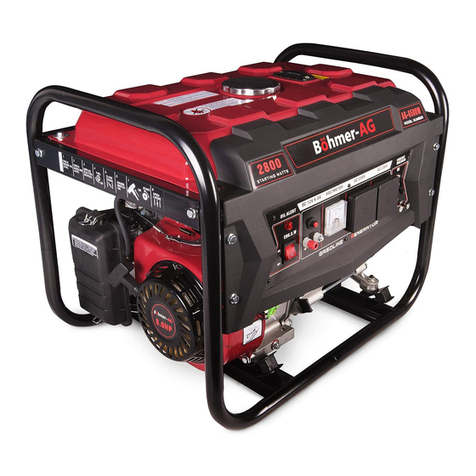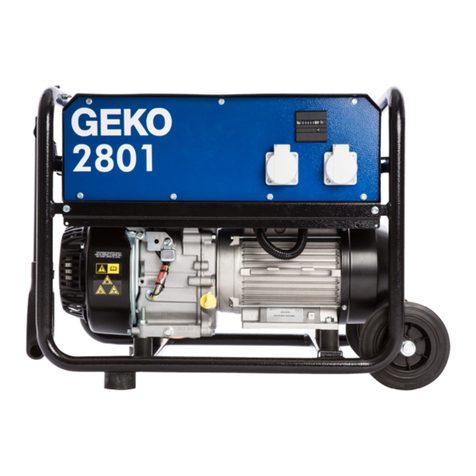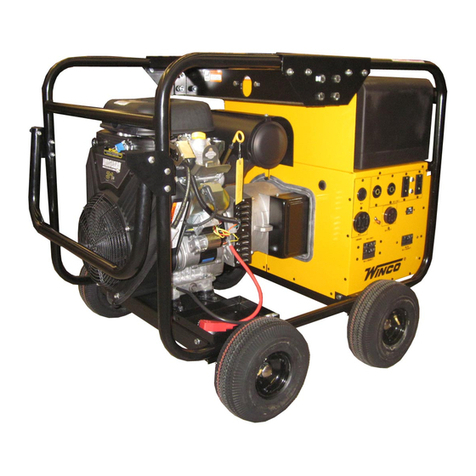sebaKMT SWG 505 User manual

Mess- und Ortungstechnik
Measuring and Locating Technologies
Produktbi
ld wie in den Prospekten ohne Rahmen
Ansprechpartner Frau Badziura
Leitungsortung
Line Locating
Rohrleitungsnetze
Water Networks
Kommunikationsnetze
Communication Networks
Elektrizitätsnetze
Power Networks
Date of release: September 1999 –
EN
12831
2846
Operating Manual
SHOCK DISCHARGE GENERATOR
SWG 505

SWG 505
II
man_swg505_en_01-4.doc

SWG 505
III
man_swg505_en_01-4.doc
Quality System Certificate
The quality management system of Seba Dynatronicand sebatel
fulfils the stringent requirements of the international quality standard
DIN ISO 9001 and of the European standard EN 29001. The German
Association for the Certification of Quality Systems has awarded us
the Quality System Certificates EN 19677 and DQS 19677-01.
How to contact us?
Seba-Dynatronic
Mess- und Ortungs-Technik GmbH
Dr.-Herbert-Iann-Str. 6
D-96148 Baunach
Germany
Tel.: (09544) 680
Fax:09544 – 2273
E-mail: sales@sebakmt.com
Internet: www.sebakmt.com

SWG 505
IV
man_swg505_en_01-4.doc

SWG 505
V
man_swg505_en_01-4.doc
Contents
1Description 1
1.1 General 1
1.2 Technical data 1
1.3 Design 2
1.4 Current supply 2
2Putting into operation 3
2.1 Safety 3
2.2 Earthing of the instrument 3
2.3 Connection to the faulty cable 4
2.4 Isolation of open cable ends 4
2.5 Selection of the surge voltage 5
2.6 Safety terms as per VDE 0104 5
2.6.1 Ready for mains connection 5
2.6.2 Ready for operation 5
2.6.3 Ready for switching On 5
2.7 Mains connection 6
2.8 Setting the surge voltage and output 6
2.9 Switching the instrument On 6
2.10 Setting the impulse sequence 7
2.11 Single-shot pulse 7
3Switching Off 9
4Description of the operating and connecting panel 11

SWG 505
VI
man_swg505_en_01-4.doc

SWG 505
1
man_swg505_en_01-4.doc
1 Description
1.1 General
The shock discharge generator SWG 505 is used for the
location of cable faults, by generating flashovers or punctures
at the weak point of the cable insulation. For this purpose, the
internal impulse capacitor is charged and then discharged into
the faulty cable via an operating spark gap. This discharge
creates a flashover noise at the fault which is picked up on the
ground surface by means of a geophone microphone,
amplified via the receiver/amplifier FLE 66 or FLE 90 Q and
then indicated acoustically and/or optically.
IMPORTANT:
The SWG 505 is a high voltage instrument. Hence, the safety
precautions have imperatively to be observed. These can be
found under paragraph 3.1. on page 5.
1.2 Technical data
Surge voltages
:
3 kV
4 kV
5 kV
Output
:
180 Ws
320 Ws
500 Ws
Impulse sequence
:
single-shot pulse or 1,5 - 6 sec.
Current supply
:
220/240 V, 45-60 Hz
Current consumption
:
2,5 A (average value)
Meter
:
0 - 6 kV (direct measurement)
Weight
:
40 kg
Dimensions (LxBxD)
:
520 x 255 x 500 mm
Standard accessories
:
a) Power cable
NK-G 01
b) Earthing cable
EK 01
c) 4 m high voltage cable
HSK 13
d) Operating manual
Special accessories
:
e) Protective cover SD 500

SWG 505
2
man_swg505_en_01-4.doc
1.3 Design
The shock discharge generator SWG 505 is a completely self-
contained instrument and can be operated without any
additional units, The four main sub-assemblies viz control unit,
high voltage generator, impulse capacitors and the operating
spark gap are mounted in a rugged 19’’housing. Modern
indicating and sensor elements, combined with VDE indicating
elements (VDE 0104) facilitate operation and handling of the
instrument.
A built-in kV-meter indicates the surge voltage and measures
the high voltage directly at the capacitor bank.
All operational and indicating elements are mounted an the
front panel of the instrument. The connections for the power
supply, earthing cable and the high voltage output have been
provided at the rear of the instrument.
The connection of the instrument on the high voltage side to
the faulty cable is made by means of a 4 m high voltage lead
with a high voltage plug connector. The instrument cannot be
put into operation unless this high voltage lead is connected.
1.4 Current supply
The SWG 505 is operated from a 220 V AC mains with a
frequency of 45 to 60 Hz. For 240 V operation, an internal
voltage matching for the mains supply of the control unit has
been provided. If the instrument is to be operated from a 110
V AC mains, the high voltage transformer has to be replaced.
The connection change-over for the transformer of the control
unit for 110 V operation has been provided.

SWG 505
3
man_swg505_en_01-4.doc
2 Putting into operation
2.1 Safety
The shock discharge generator SWG 505 releases dangerous
contact voltages. Hence the instrument must be operated by
specialists or personnel who have been trained or instructed in
the use of the instrument. The following safety precautions
should be adhered to
Para. 2.2.
Earthing of the instrument
Para. 2.3.
Connection to the faulty cable
Para. 2.4.
Isolation of open cable ends
Para. 2.5.
Selection of a suitable surge voltage
Para. 2.6.
Safety terms.
2.2 Earthing of the instrument
Prior to putting into operation, the instrument has to be
earthed. For this purpose, the earthing terminal (11) is to be
connected to a reliable protective earth by means of the
earthing lead supplied. The protective earthing provided
through the earth contact of the mains supply lead is not
sufficient.

SWG 505
4
man_swg505_en_01-4.doc
2.3 Connection to the faulty cable
The plug of the high voltage lead is connected to the high
voltage socket (13) and is secured by means of the fixing
screw. Now a micro contact inside the instrument closes and
renders the Instrument ready for connection of a mains
supply.
After the faulty cable has been disconnected and verified to be
dead, the high voltage lead can be connected. For this
purpose, the wire clamp is fixed to the faulty phase conductor,
whereby care should be taken to ensure a good contact. The
sheath clamp is screwed onto the sheath or screen of the
defective cable. Additionally, in the case of a fault between
two cores, one of these cores has to be connected to the
sheath or screen and in the event of plastic cables, to system
earth.
2.4 Isolation of open cable ends
Since the high voltage impulses applied to the defective cable
assume dangerous values, the cable ends must be isolated as
per VDE 0104 in order to avoid physical contact. This also
goes for teed low voltage cables which, if need be, have to be
disconnected in order to avoid flashovers in the installations or
terminal boxes.
Only when dealing with longer cables (exceeding 100 m) it is
recommended to short-circuit and earth one cable end. In
spite of the shorted conductors, a flashover can be obtained at
the fault.

SWG 505
5
man_swg505_en_01-4.doc
2.5 Selection of the surge voltage
The selection of the surge voltage mainly depends an the test
voltage of the faulty cable and the installations. A reduction in
surge voltage also reduces the output which is due to the fact
that the output is governed by the square of the voltage.
Surge impulses which do not create a breakdown are reflected
at the far end of the cable, whereby the Impulse voltage is
doubled. This has to be taken into account as per VDE 0298.
2.6 Safety terms as per VDE 0104
2.6.1 Ready for mains connection
Indicated by a white pilot lamp (6).
Mains voltage is connected
Instrument is not on.
2.6.2 Ready for operation
Indicated by a green pilot lamp (7).
Instrument is on.
No high voltage.
Output earthed.
2.6.3 Ready for switching On
Indicated by a red pilot lamp (5).
Instrument is on. DANGER!!
Green pilot lamp goes out.
CAUTION: HIGH VOLTAGE IS ON
NOTE
If the green pilot lamp goes out and the red pilot lamp does
not light up, the instrument is also ready for switching on !!

SWG 505
6
man_swg505_en_01-4.doc
2.7 Mains connection
The earthed power supply lead is connected to socket (12).
The mains voltage should be 220 - 240 V. A mains frequency
of 45 - 60 Hz is permissible.
2.8 Setting the surge voltage and output
The desired surge voltage is selected by means of rotary
switch (10):
Position I :
3 kV
180 Ws
Position II :
4 kV
320 Ws
Position III :
5 KV
500 Ws
2.9 Switching the instrument On
Prerequisites :
a)
Earthing of the instrument
b)
Connection to the faulty cable
c)
READINESS FOR MAINS CONNECTION
(white pilot lamp).
Operate :
I:
Luminous pushbutton (6) white
Result
:
Luminous pushbutton (6) still lights
Switching state
I:
READY FOR OPERATION
Indication
:
Luminous pushbutton (7) green
Operate
II:
Luminous pushbutton (7) green
Result
:
Luminous pushbutton (7) goes out
Switching state
II:
READY FOR SWITCHING ON
or High Voltage connected.
Indication
I:
Luminous pushbutton (5) red
Meter
:
kV-meter 6 kV

SWG 505
7
man_swg505_en_01-4.doc
2.10 Setting the impulse sequence
Rotary control (9) is combined with a rotary switch. When the
rotary control is turned fully to the left, the automatic impulse
sequence is switched off (single-shot pulse). If the rotary
control is turned to the right (clockwise), then the Impulse
sequence can be continuously selected after the switching
threshold has been passed. The shortest impulse sequence
(fully to the left) is 1,5 seconds and the longest (fully to the
right) 6 seconds. One scale division corresponds to approx.
0,5 seconds.
2.11 Single-shot pulse
In order to trigger single-shot pulses, e.g. by radio command,
the rotary control (9) is to be set fully to the left, whereby a
switching threshold has to be crossed. A single-shot pulse is
triggered by means of pushbutton (8).


SWG 505
9
man_swg505_en_01-4.doc
3 Switching Off
After completion of the test, the instrument is switched off by
operating the luminous pushbutton (5), whereby both the
control unit and the high voltage generation are switched off.
Simultaneously, the instrument and the connected cable are
automatically discharged. The pointer of the kV-meter returns
to Zero.
Important:
Prior to disconnecting the high voltage lead from the cable
under test, both connections have to be touched with an
earthing rod in order to ensure a "visible" discharge and
earthing.

SWG 505
10
man_swg505_en_01-4.doc

SWG 505
11
man_swg505_en_01-4.doc
4 Description of the operating and connecting panel
Figure 1 : Operating and connecting panel

SWG 505
12
man_swg505_en_01-4.doc
1
kV-meter :
0 - 6 kV
2
Microfuse/Mains circuit :
F3 (T 2 / 250 D)
3
Microfuse/Mains circuit :
F1 (T 2 / 250 D)
4
Microfuse/Control circuit :
F2 (M 0.5 / 250 D)
5
Luminous pushbutton :
(red)
when operated: "OFF"
Indication "READY FOR
SWITCHING ON"
*6
Luminous pushbutton :
(white)
when operated: "ON"
Indication "READY FOR
MAINS CONNECTION"
*7
Luminous pushbutton :
(green)
when operated: "HIGH
VOLTALE ON"
Indication "READY FOR
OPERATION"
8
Luminous pushbutton :
(blue)
single-shot pulse
9
Rotary control :
Impulse sequence 1,5 - 6
s/pulse
10
Rotary switch :
3 / 4 / 5 kV
11
Connection socket :
for earthing lead
12
Mains connection :
220 V, 45 - 60 Hz (or other
voltages)
13
High voltage output :
for the high voltage lead.
14
NAG connector
15
Key switch
*IMPORTANT:
The luminous pushbuttons 5/6/7 have dual functions:
1.
PUSHBUTTONS for operation
2.
PILOT LAMPS for indication of the switching state.

SWG 505
13
man_swg505_en_01-4.doc

Table of contents
Popular Portable Generator manuals by other brands

Champion Power Equipment
Champion Power Equipment para link 500468-WL-EU Operator's manual

Generac Power Systems
Generac Power Systems GP Series owner's manual
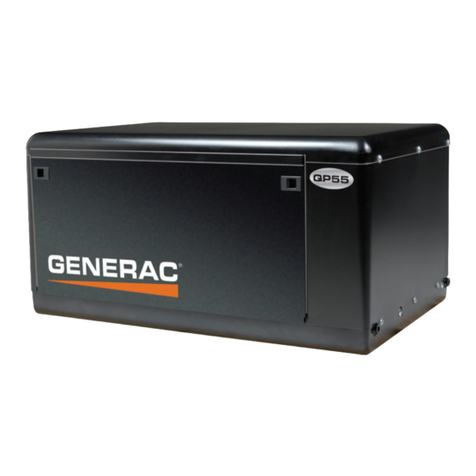
Generac Power Systems
Generac Power Systems 005411-0 owner's manual

DUROMAX
DUROMAX DUALFUEL XP11500EH user manual
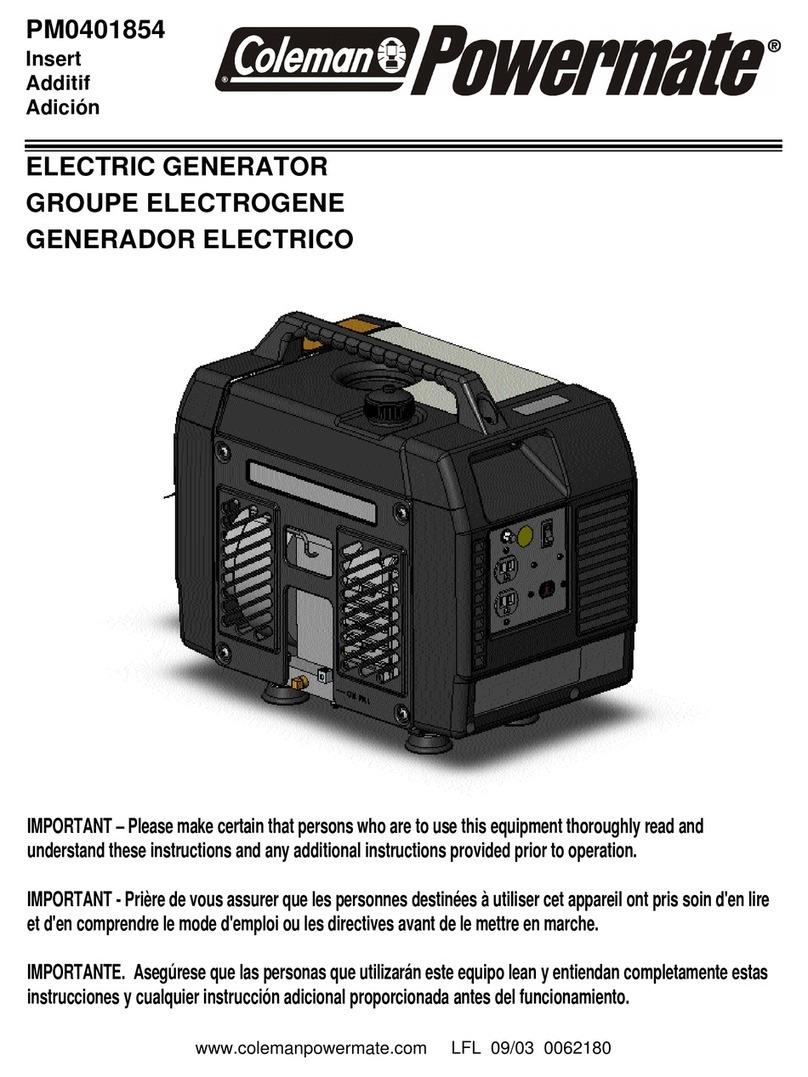
Powermate
Powermate PM0401854 manual
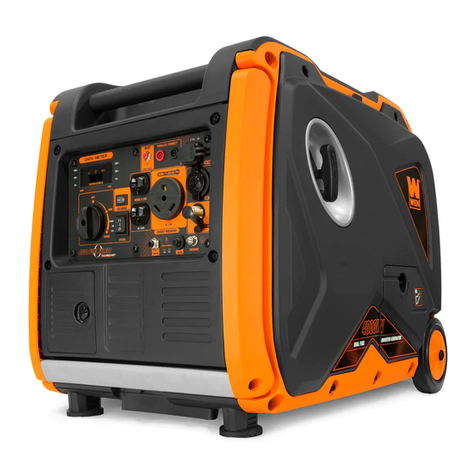
Wen
Wen DF400i instruction manual




